1lumen selects and reviews products personally. We may earn affiliate commissions through our links, which help support our testing.
Fenix E03R v2 review
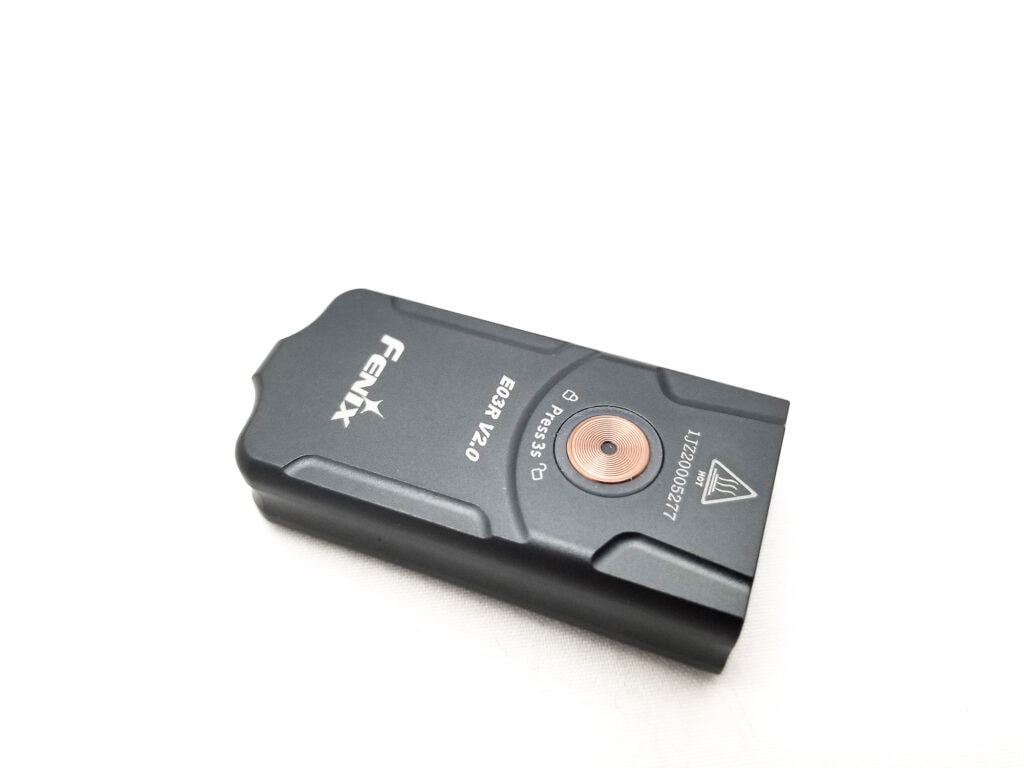
Fenix E03R v2 specs
| Brand & Model | Fenix E03R v2 |
|---|---|
| Flashlight category | Keychain Light |
| LED | 2 white LEDs, 1 red LED |
| Max. output | 500 |
| Max. beam distance | 90 m |
| Max. beam intensity | 2082 cd |
| Battery config. | Built-in 400 mAh lithium polymer |
| Onboard charging | USB type C |
| Main modes | 6 |
| Blinkies | Strobe |
| Waterproof | IP66 |
| Review publication date | August 2023 |
Review intro:
Today we’ll be taking a look at a Fenix light. Fenix and I sort of have a special proclivity since I must have reviewed about a dozen different Fenix products, from the E-Lite to the LR80R flagship. The consensus? These are very nice, innovative, and functional illumination tools made for hard-working guys and gals who actually depend on a flashlight as part of their livelihood. In short, like Olight, Nitecore, and Acebeam, if you need a flashlight for work, Fenix has you covered.
On deck for today is an OG in their product lineup, and part of their E series. These lights are designed for general purpose and EDC use (E for ‘everyday’ maybe?). It’s been around for a while, and the first version was getting a bit long in the tooth, so Fenix made it better! Add a LED, bigger battery and voila! The E03R V2 keychain light.
I have a soft spot in my heart for good keychain lights and I’ve owned at least one Mag Solitaire and a Streamlight Keymate graced my keychain for a few years. My current keychain light is the Fenix E-Lite and Olight i2R Eos, and they’ve been great mini lights. Let’s see if the E03R V2 can usurp them!
Package quality.
The Fenix E03R v2 came in a blister pack with the light front and center with the accessories and such in a compartment right behind it. It’s a tidy package and perfect for retail on the hang tag rack. Here’s what’s inside:
- Fenix E03R v2 flashlight
- Split ring
- Manual
- USB type C cable
- Warranty card
- Promotional documentation
This light was sent from another reviewer, so it had been opened previously, but all the bits were inside. Overall, a bit more kit than I was expecting, but not surprising from Fenix.
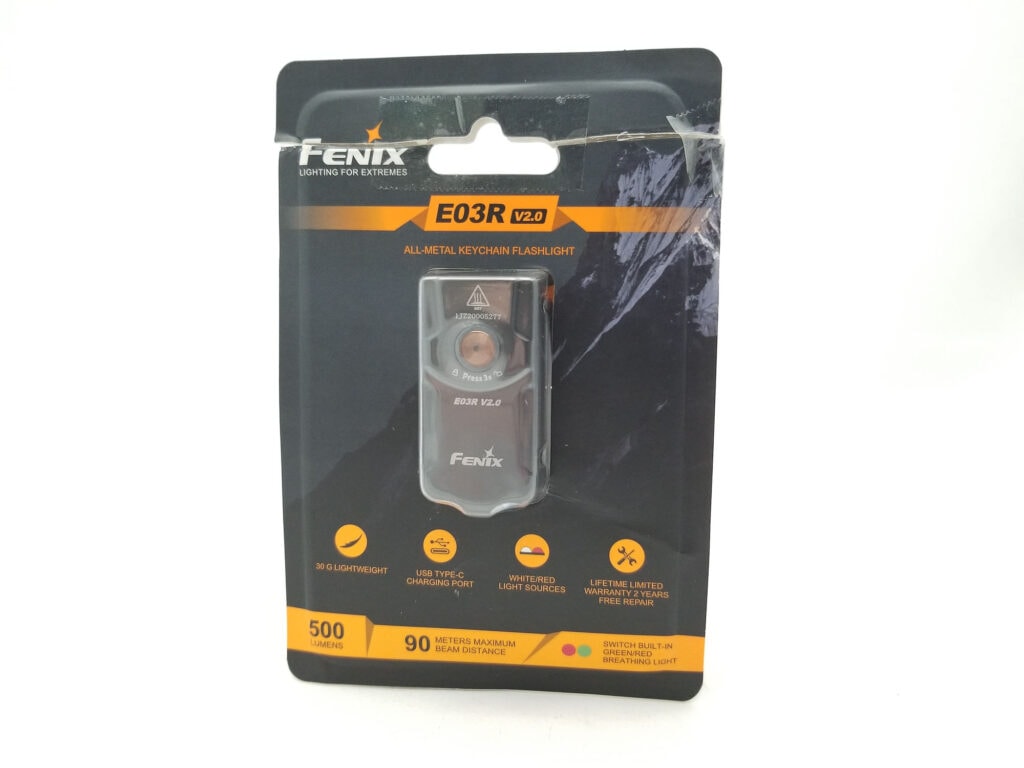
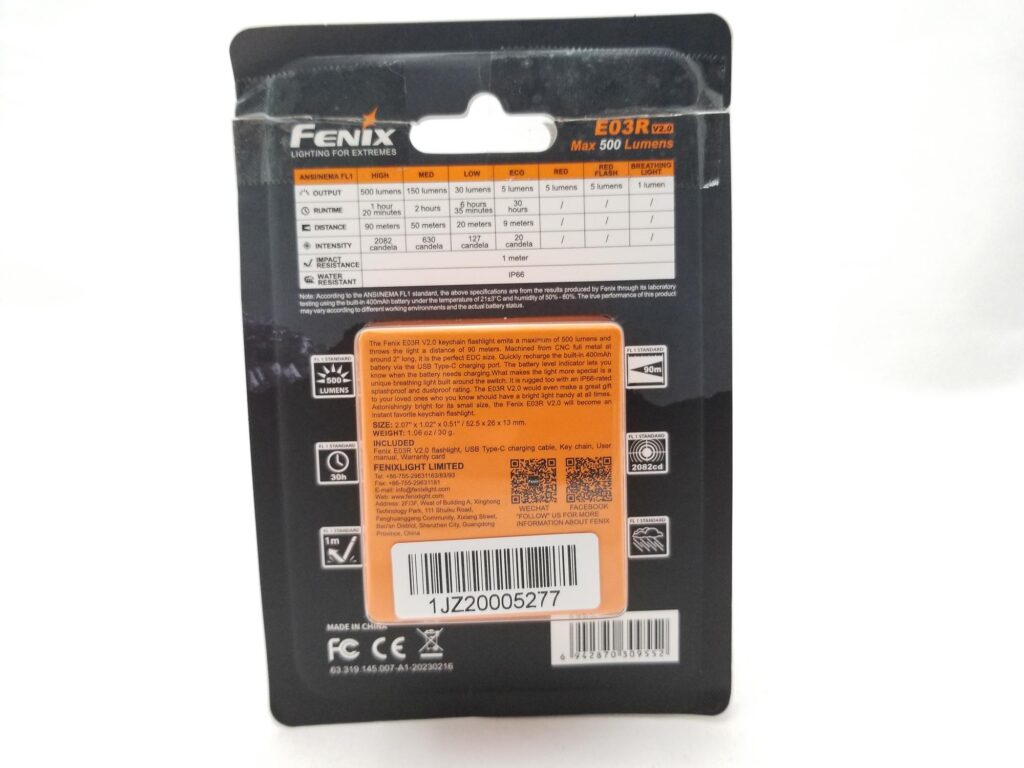
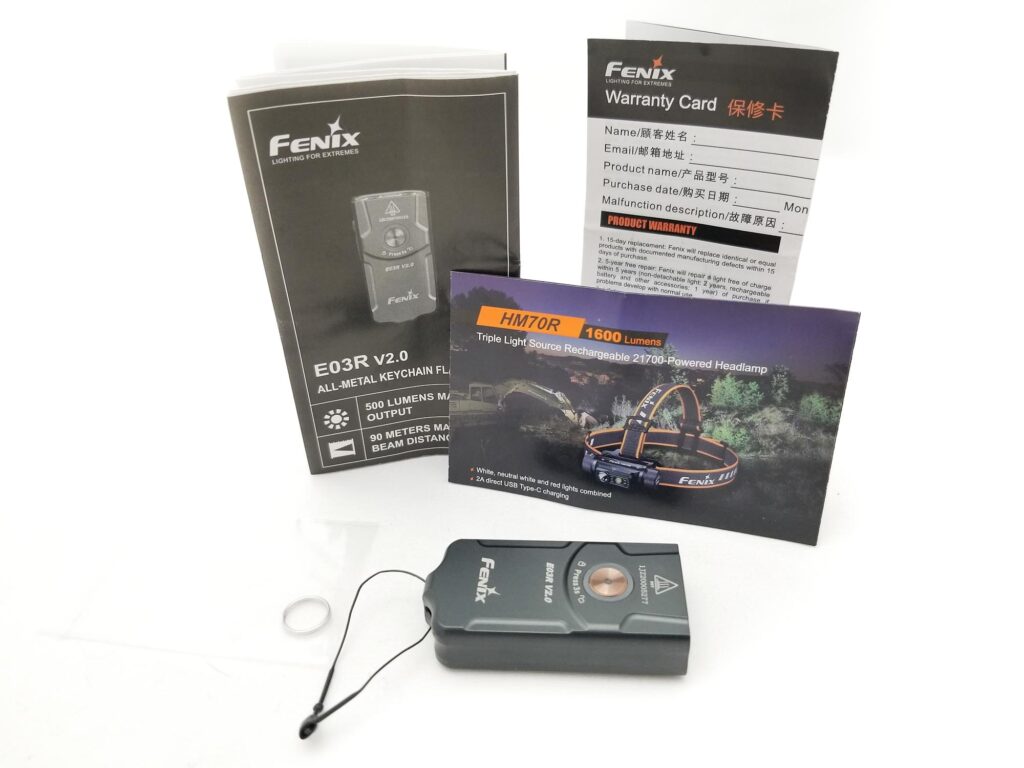
Flashlight in use
The Fenix E03R v2 is a keychain light first, but it could also do EDC duty as a backup light. Toss it in your center console of your car, the glove box, tool box, junk drawer, or clip it to your key ring. This is a super handy, ultra versatile light, and there are many who can testify of how a keychain light saved their skin more than once (I can). It’s pretty small, but not the smallest (or lightest) keychain light. It’s about twice as heavy as a Cyansky M2, Fenix’s own E-Lite, and the Olight i2R EoS, but the tradeoff is that it’s about 4 times as bright.
It fits great in the hand, solid and with good heft. The flat profile (under 14 mm tall) makes pocket carry easy and nearly invisible. There’s a single e-switch on one side, with a fancy bronze bezel and switch cover flanked by an opaque ring with LEDs underneath for charge and on state.
The switch: The button sits nearly flush, and finding it by feel is tough without practice, and the travel from touch to on is so short. It’s not a great experience. It’s…functional. The USB type C charge port is on the side, and out back is a split ring or lanyard attachment point. No tail stands with this one, and no, it won’t roll off an inclined surface (flat things usually don’t).
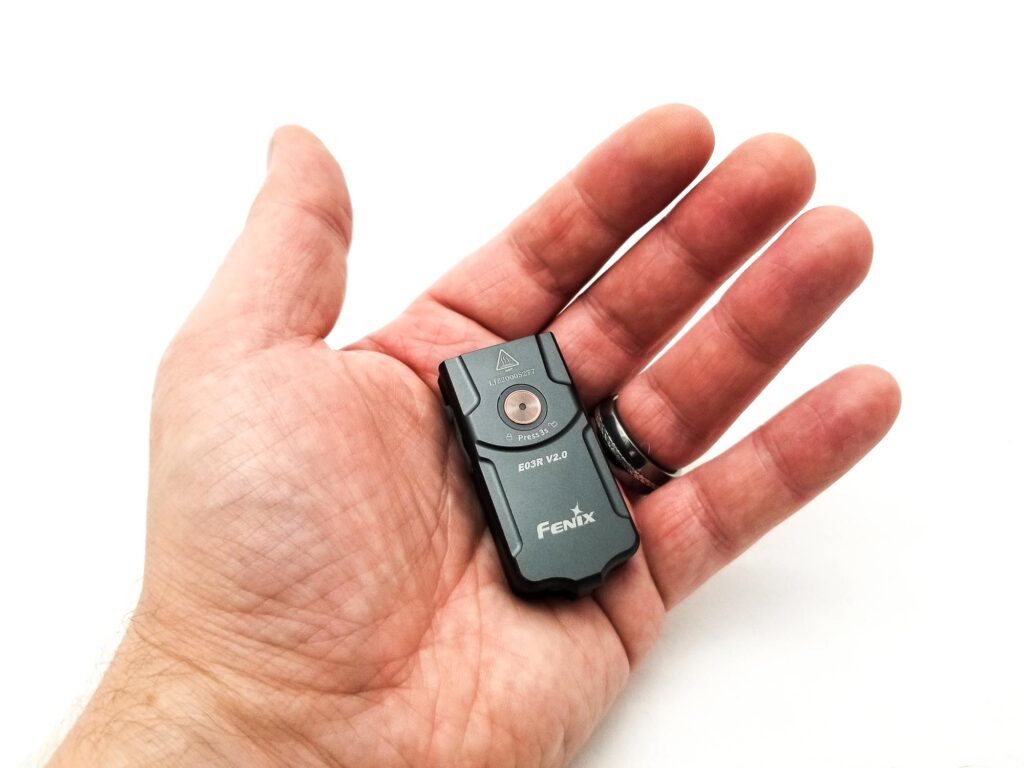
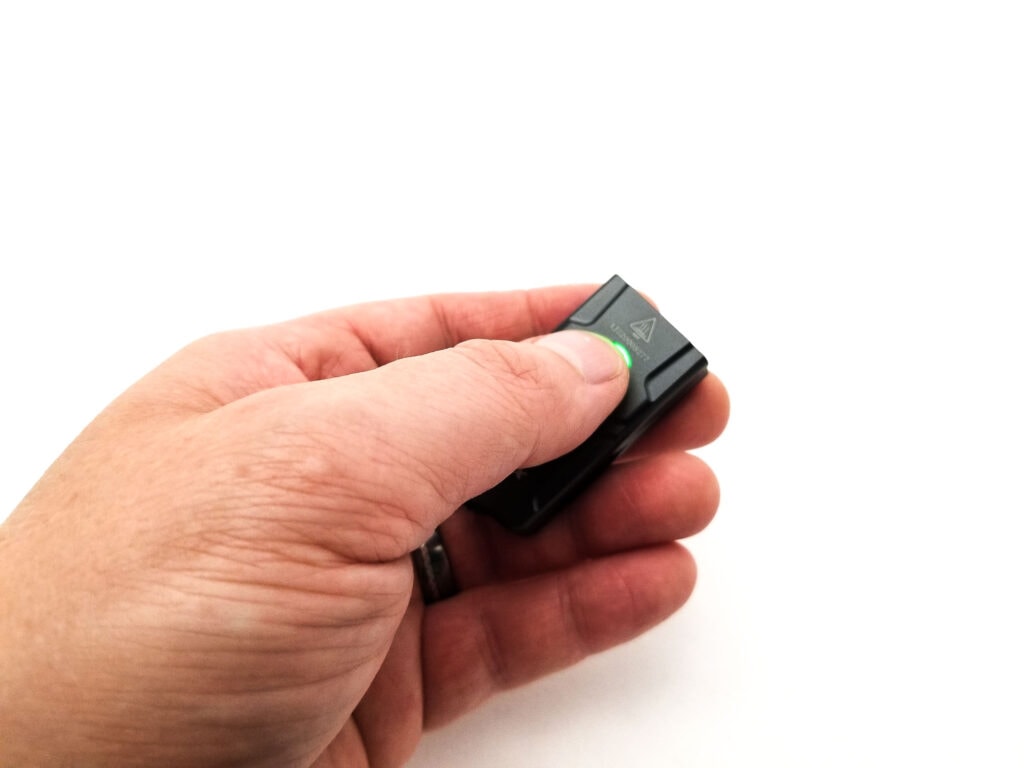
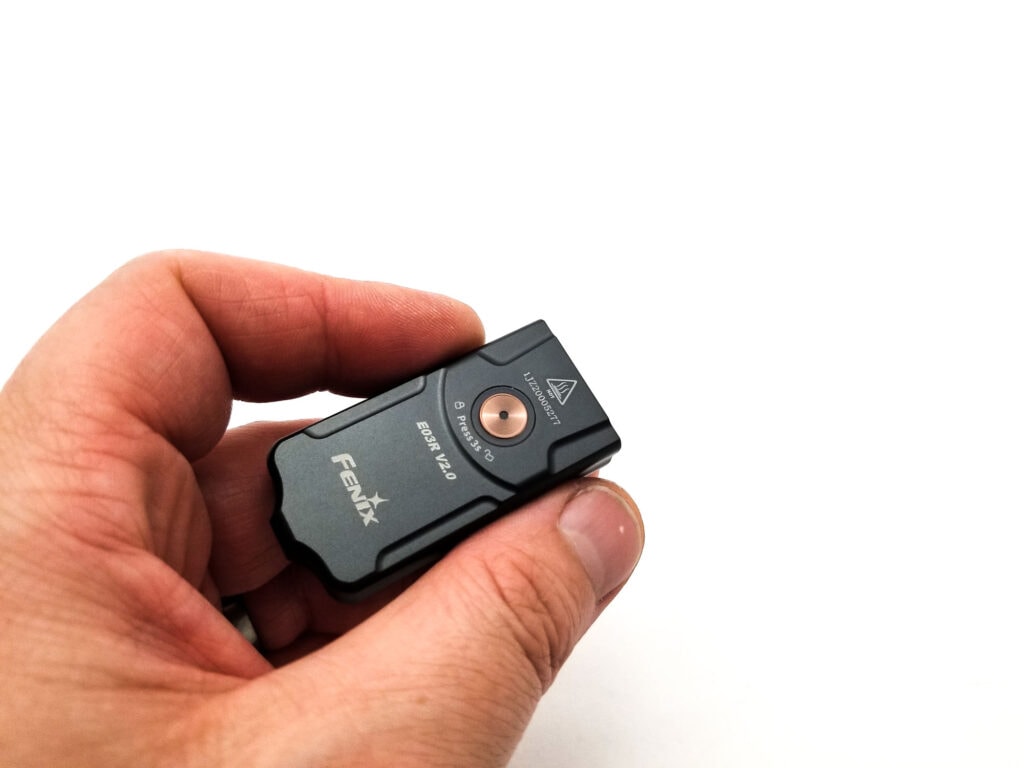
Build Quality and Warranty
The Fenix E03R v2 is a Fenix product so it’s going to be at the top of the heap quality-wise. Fenix’s products are all top-notch, and the E-series are no different even if they carry a ‘lower’ price point. The E03R v2 isn’t cheap at around $40, but this is a 500 Lumen dual LED micro flashlight and I’m not going to split hairs over that. You get what you pay for.
As mentioned, no qualms about the build quality or overall quality. The body is aluminum of the 6061T6 variety, and the machining is ultra tidy, with no sharp edges. It feels substantial and high quality in the hand. The TIR lens fits perfectly, as does the switch. The finish is semi gloss and comes in gray or blue. The sample came with gray anodizing, and it’s, you guessed it, perfect stem to stern with no blemishes or anomalies. The silkscreening and laser-etching is also superb. Fenix gives the E03R an IP66 rating, so it’s good for heavy soakings and dusty environments, but I’d be leery of dunking it.
Warranty? Fenix products carry a limited lifetime warranty. Factory defects are covered, and products are repaired or replaced (at Fenix’s discretion). The warranty doesn’t cover the usual suspect: Intentional/deliberate damage, unauthorized repairs or disassembly, or normal wear and tear (non-removable batteries for example).
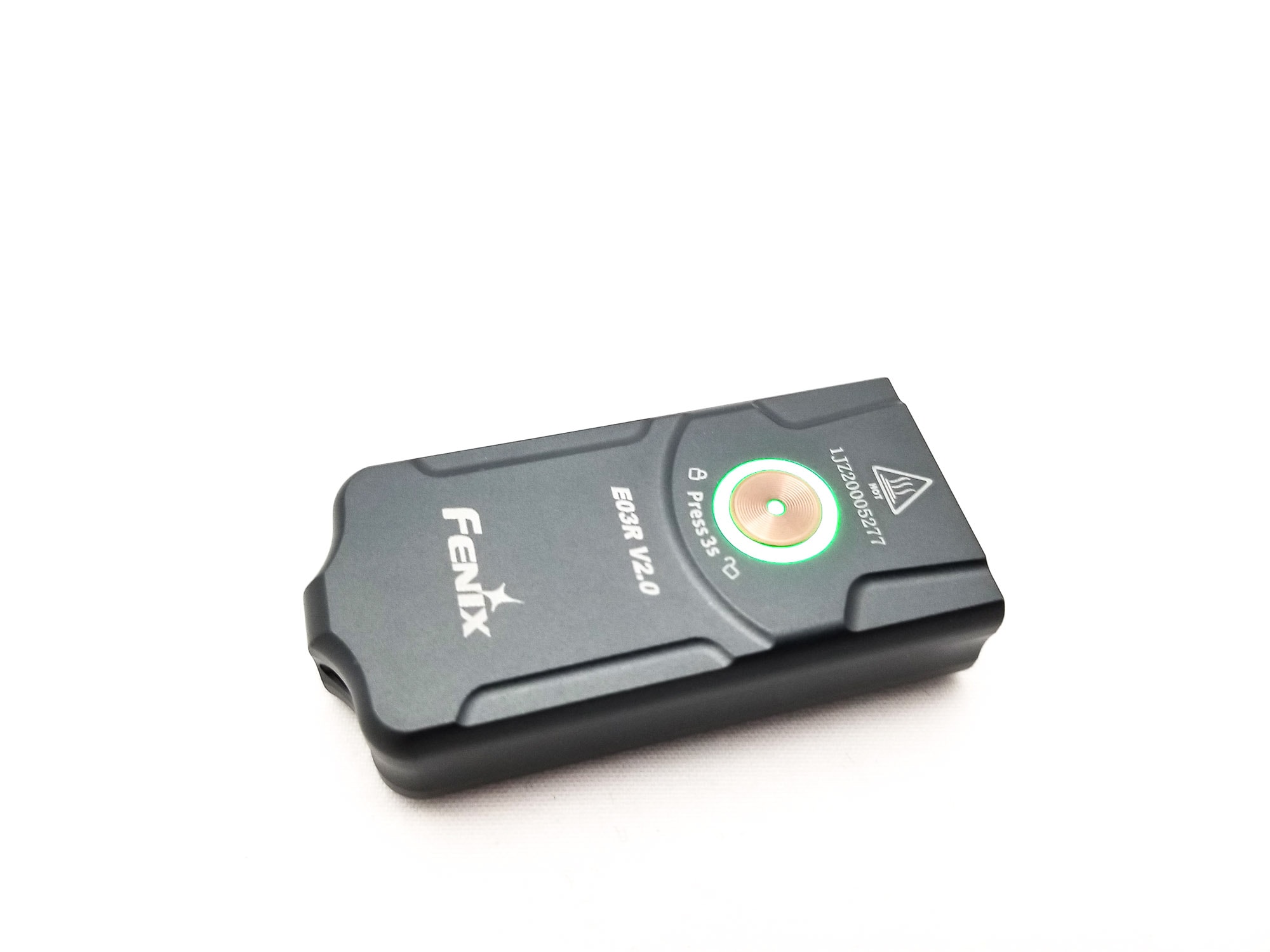
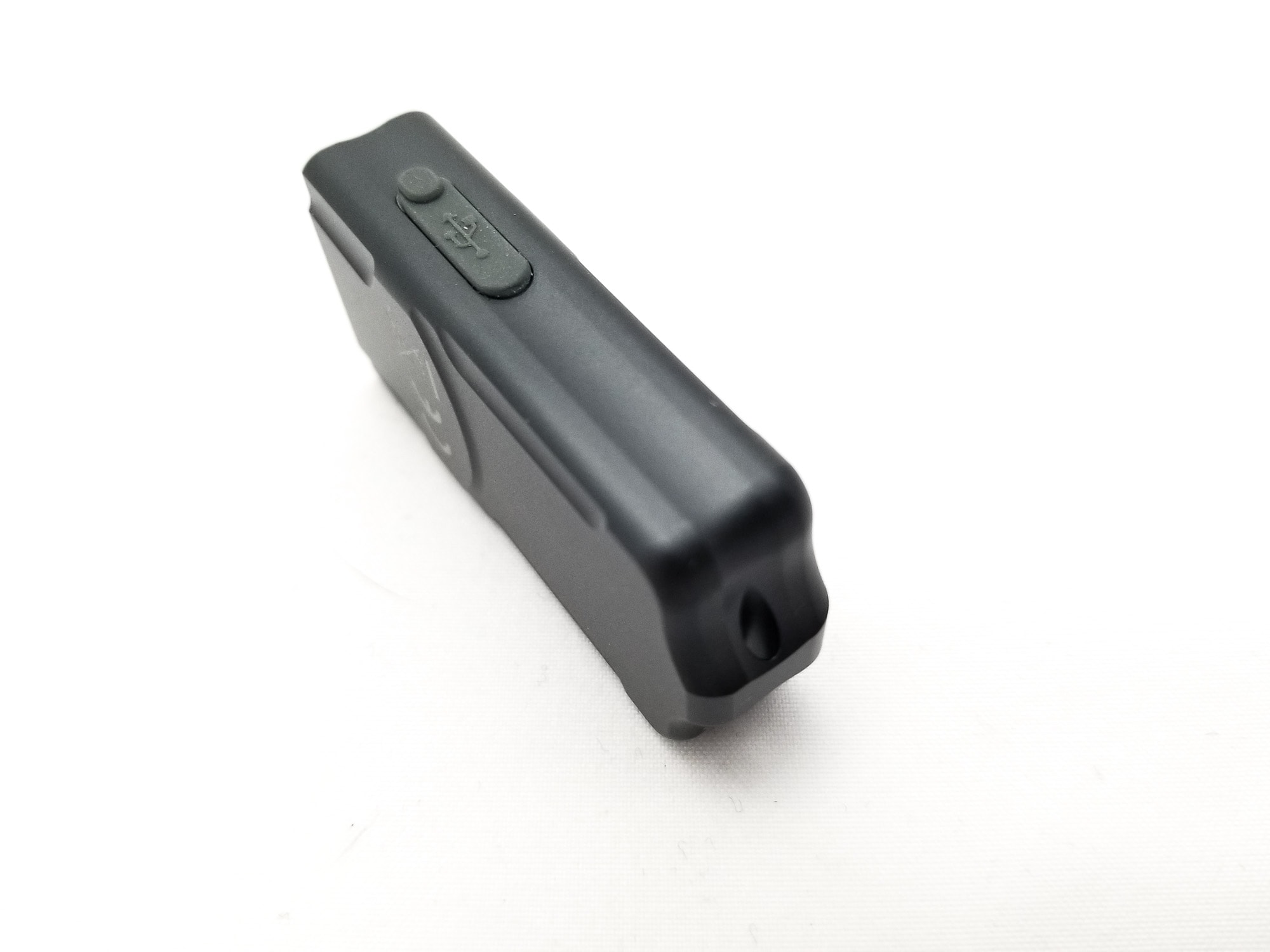
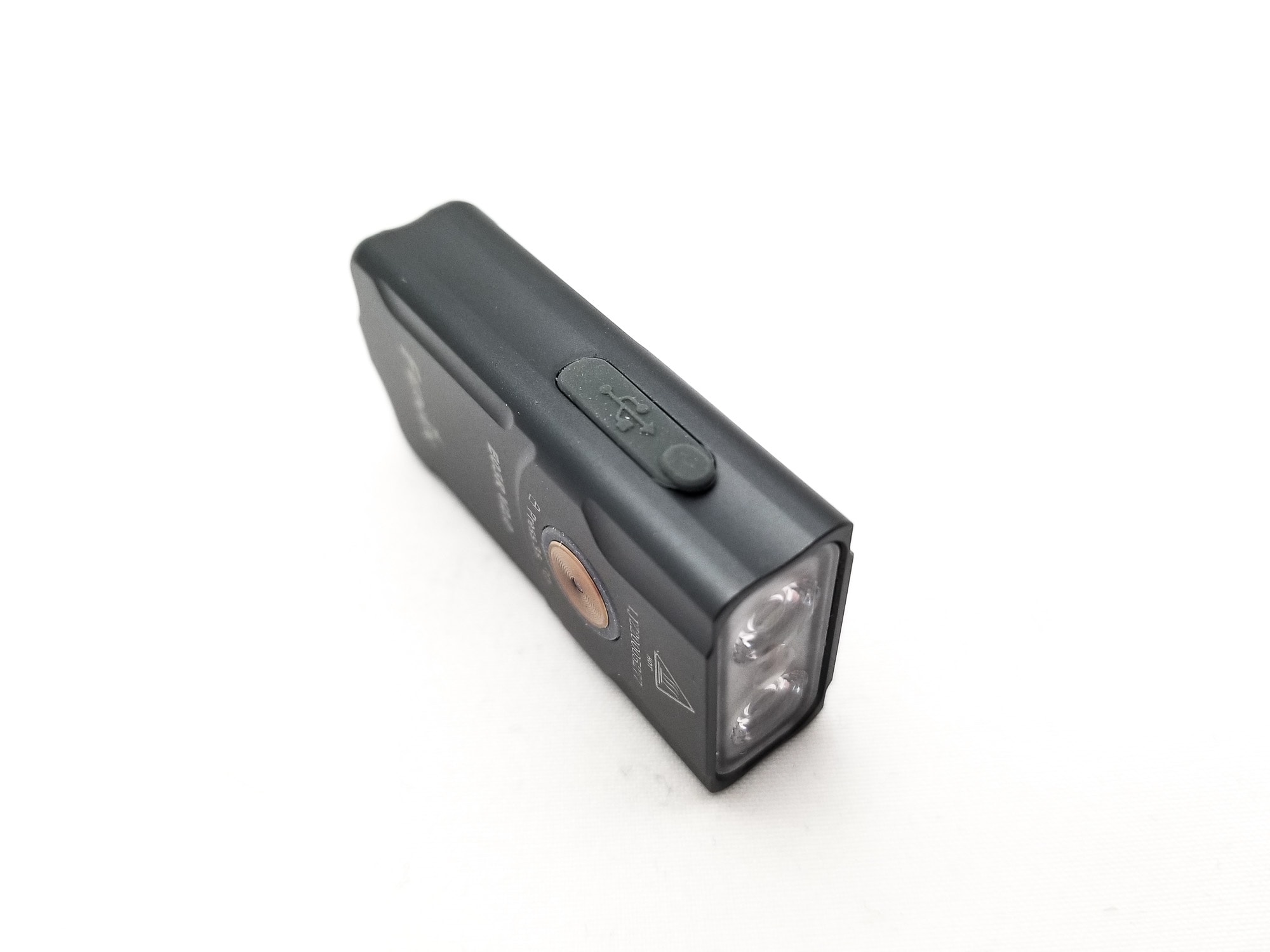
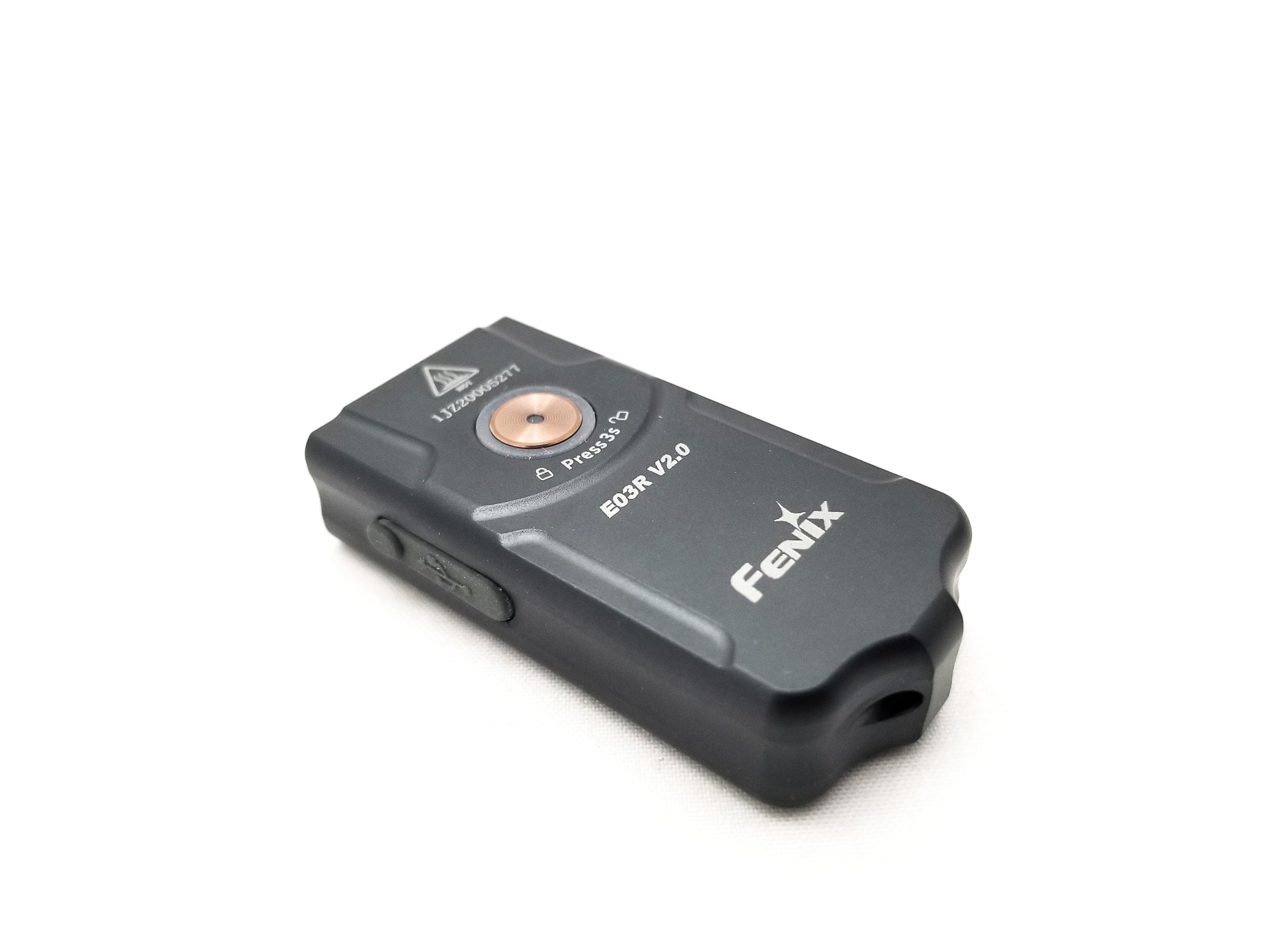
LED, Lens, Bezel, Beam, and Reflector
There’s some mystery LEDs hiding out in the E03R v2. The original E03R had a single white LED made by MATCH, the C18A (also shared by the E-Lite) and an Everlight 2835 red LED.
The V2 adds an extra white LED and retains the single red LED, although this time they’re remaining anonymous. I suspect they’re the same though. They’re tiny, smaller than a Luminus SST20 and cool white only. The red LED is positioned between the white LEDs and everything sits under a single PMMA TIR lens with the two white LED TIRs and single lens for the red LED. The Opple Lightmaster Pro has the white LEDs coming in at CCT 5880K and CRI Ra 66. The duv is 0.0057.
The MATCH LEDs were pretty green at low currents, but not too bad. The beam from the E03R V2 is pretty good, with a somewhat visible bright central area and a nice broadcast of light with good side illumination. This isn’t a throwy beam, but strikes a good balance of throw and flood.. For up close, it’s great.
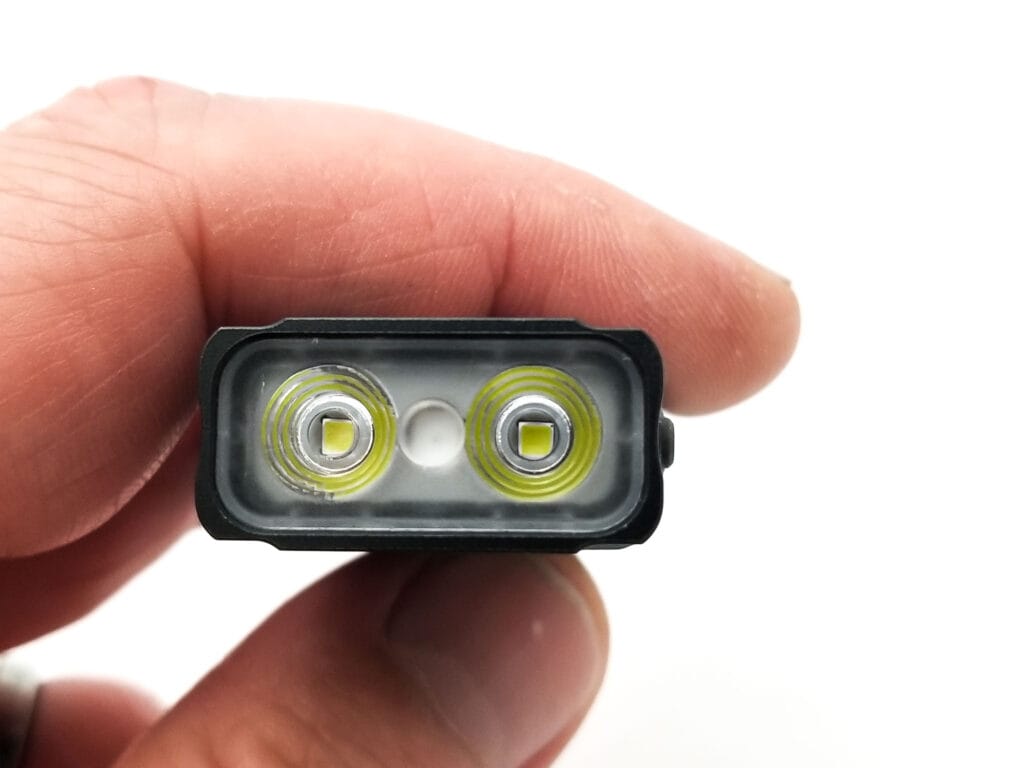
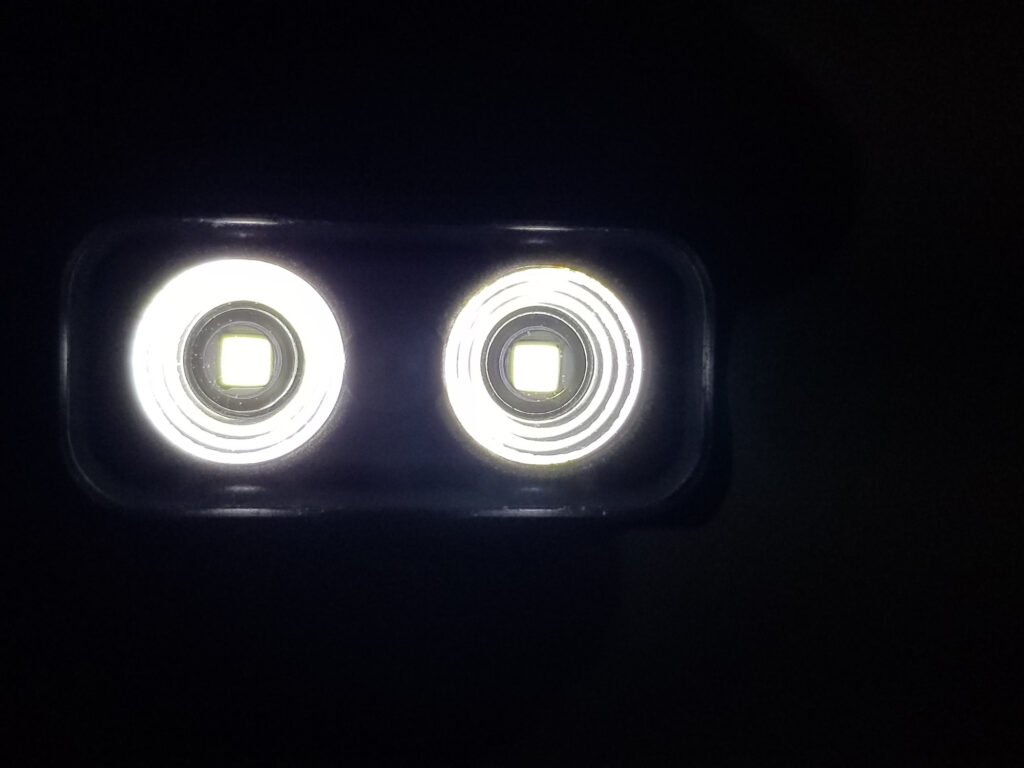
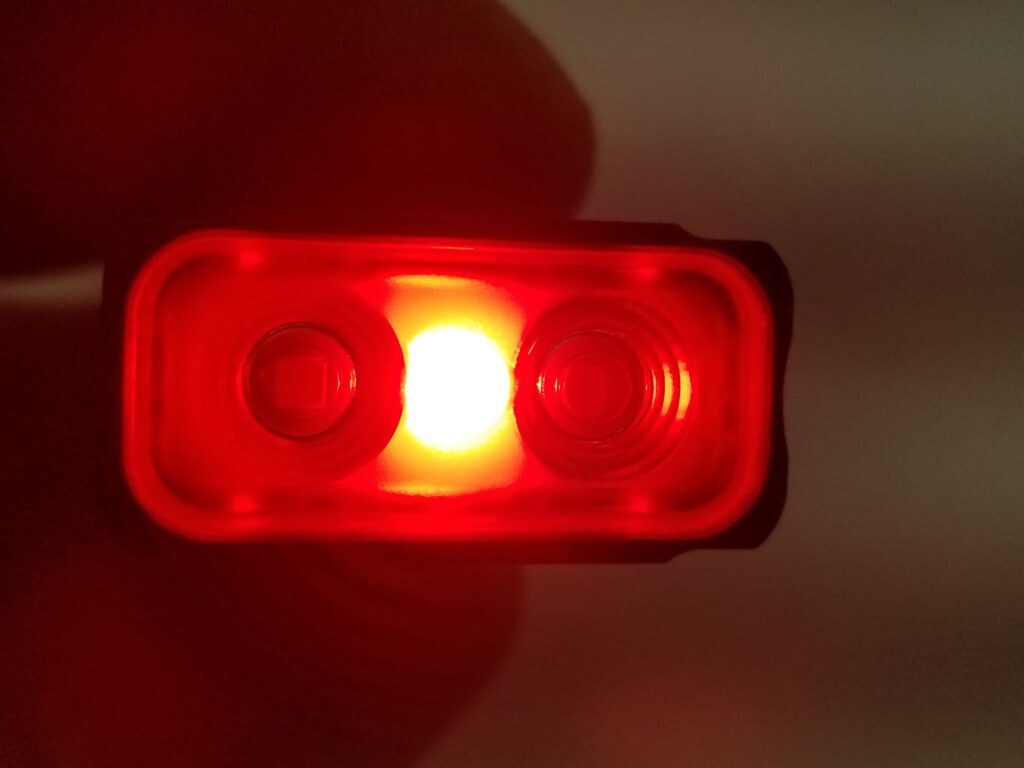
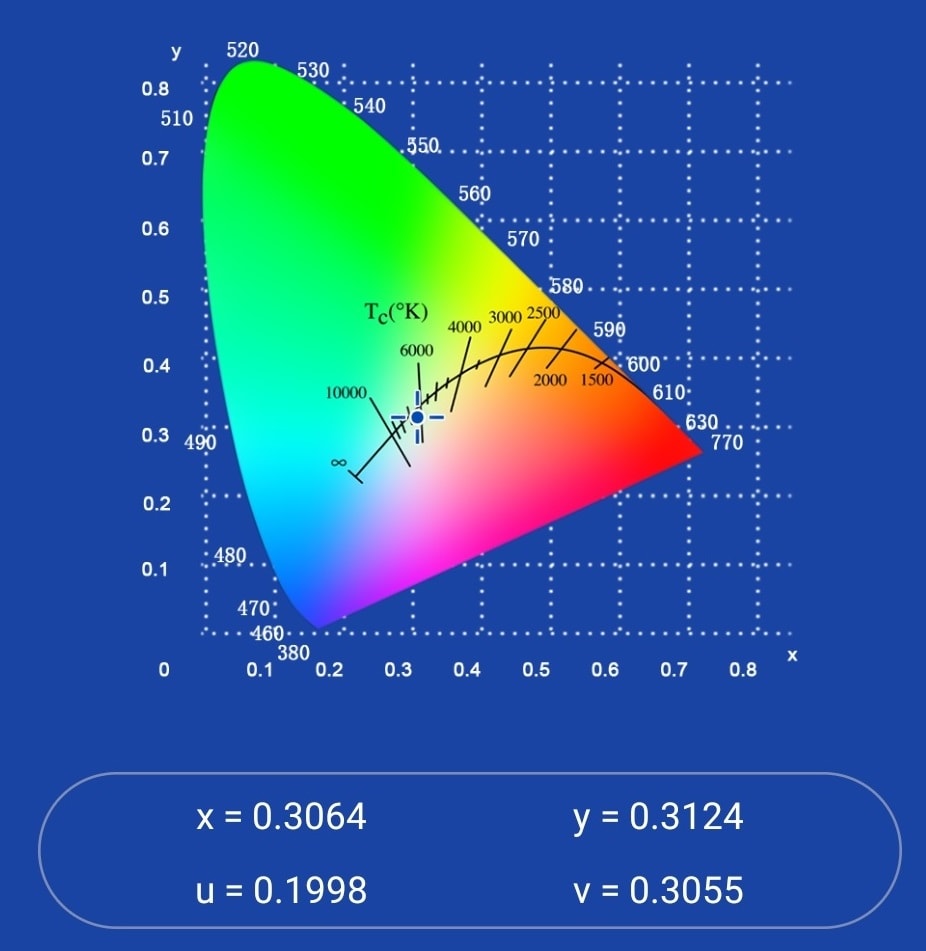
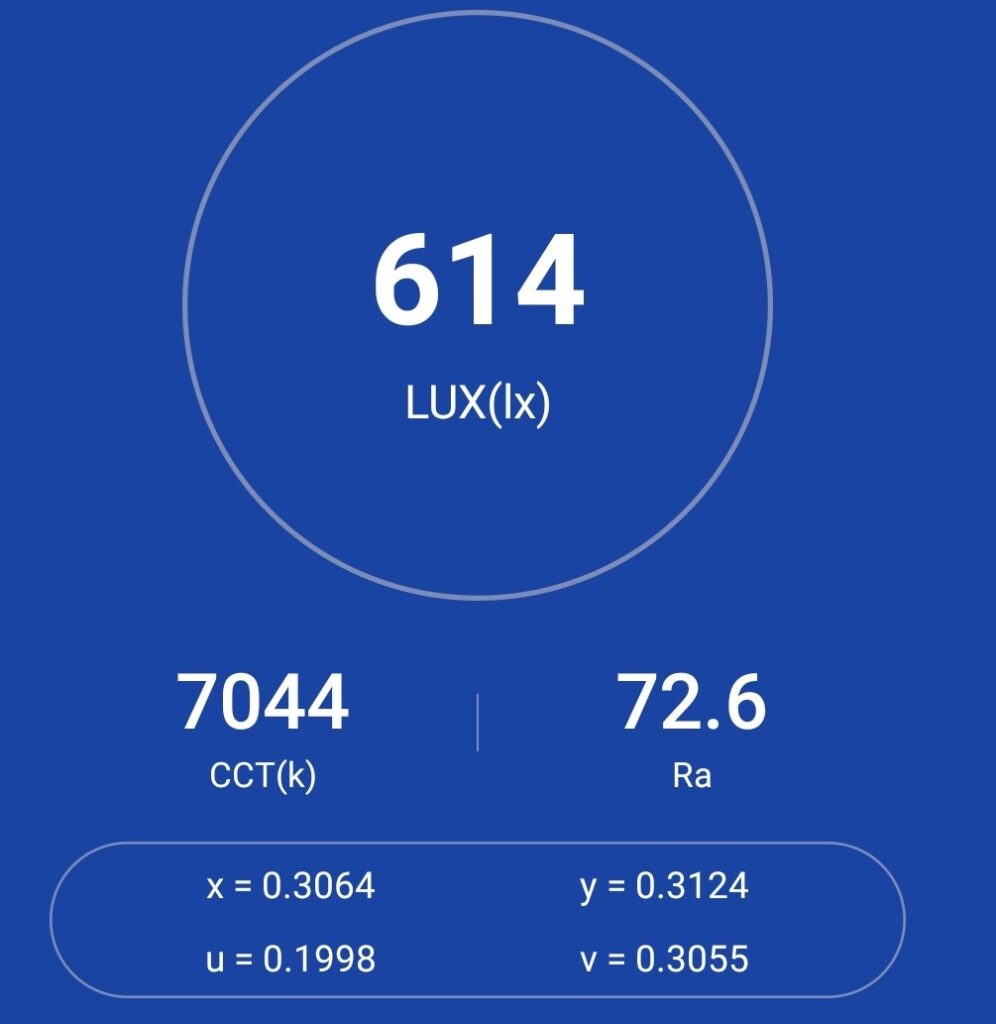
Dimensions and its competition
| Fenix E03R V2 | Millimeters | Inches |
|---|---|---|
| Length | 53 mm | 2.1 in |
| Width | 26 mm | 1 in |
| Height | 13 mm | 0.5 in |
Dimensions are rounded to the nearest millimeter, and to the nearest tenth of an Inch.
Weight:
| Fenix E03R V2 | Weight in grams | Weight in oz |
|---|---|---|
| With built-in battery: | 30 g | 1.7 oz |
Weight is rounded to the nearest gram, and to the nearest tenth of an oz.
This is a pretty small light for being so powerful, but it’s roughly twice as heavy as the Cyansky M200 (18 grams) and 10 grams heavier than the Olight i2R EoS and E-lite. It’s about on the cusp of what I’d dangle from my key ring, since a heavy key ring is bad for your vehicle’s ignition tumbler assembly (if your car still uses a key anyway).
Flashlight size comparison with its competition:
Group 1 left to right, small flashlights: Fenix E-Lite, Olight i3t EOS, Fenix E03R v2, Cyansky M2, Olight i2R EoS
Group 2 top to bottom: Manker E14 IV, Lumintop FWAA, Fenix E03R v2,
Group 3 top to bottom: Fenix E09R, Thorfire TG06, Sofirn SP10 Pro, Fenix E03R v2, Lumintop FWAA
Group 4 reflectors left to right: Olight i3t EOS, Fenix E03R v2, Cyansky M2, Olight i2R EOS
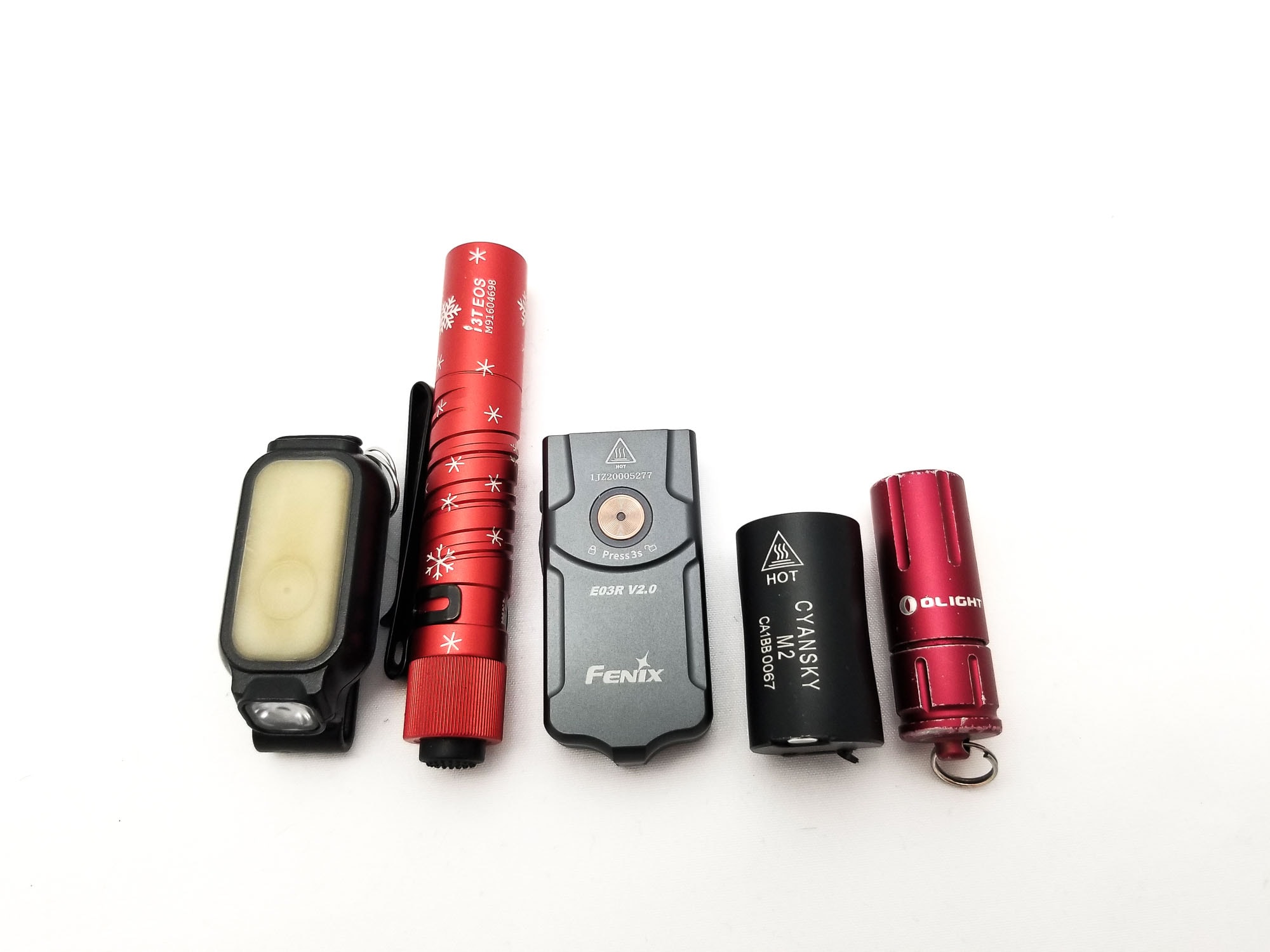
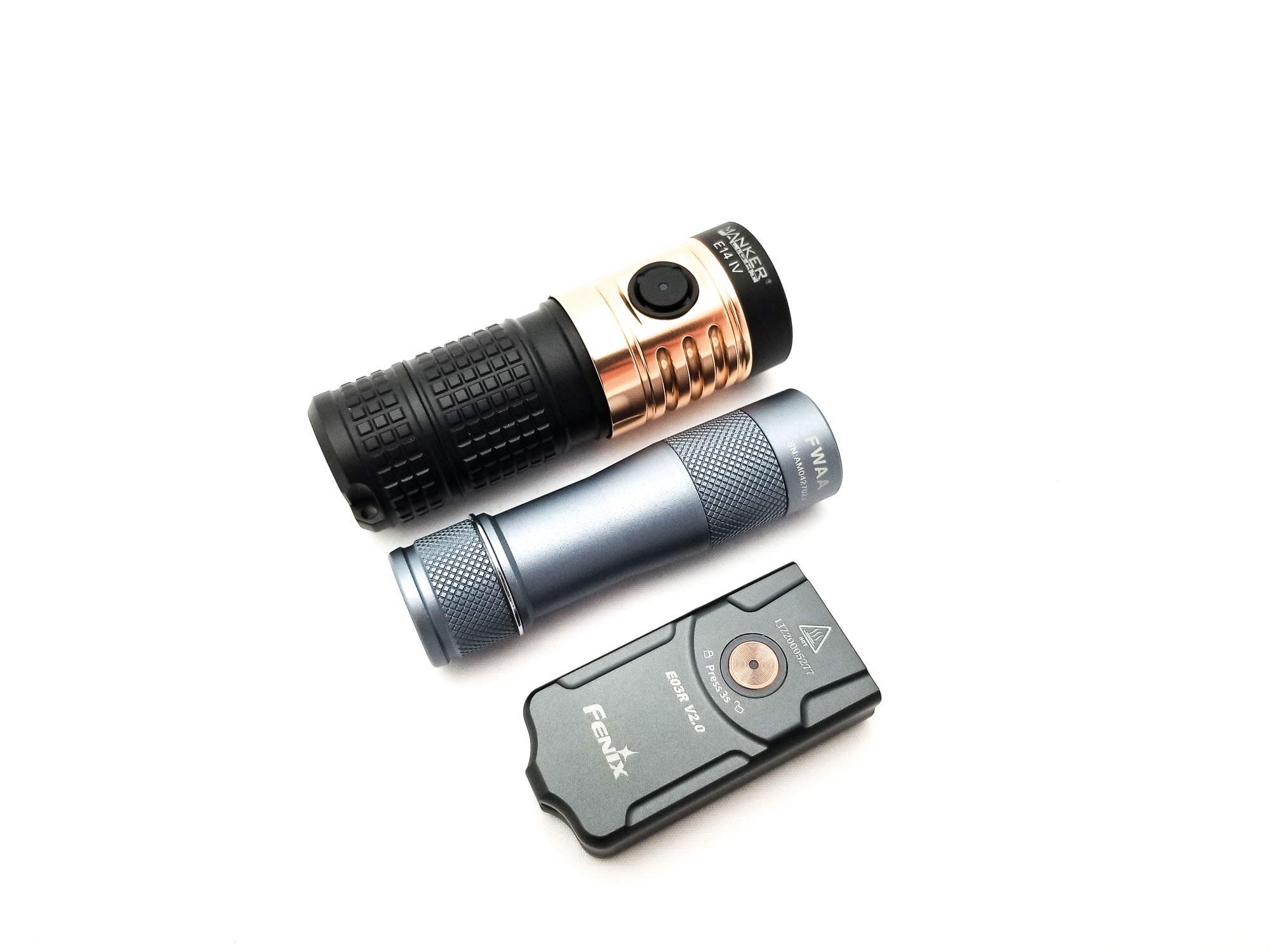
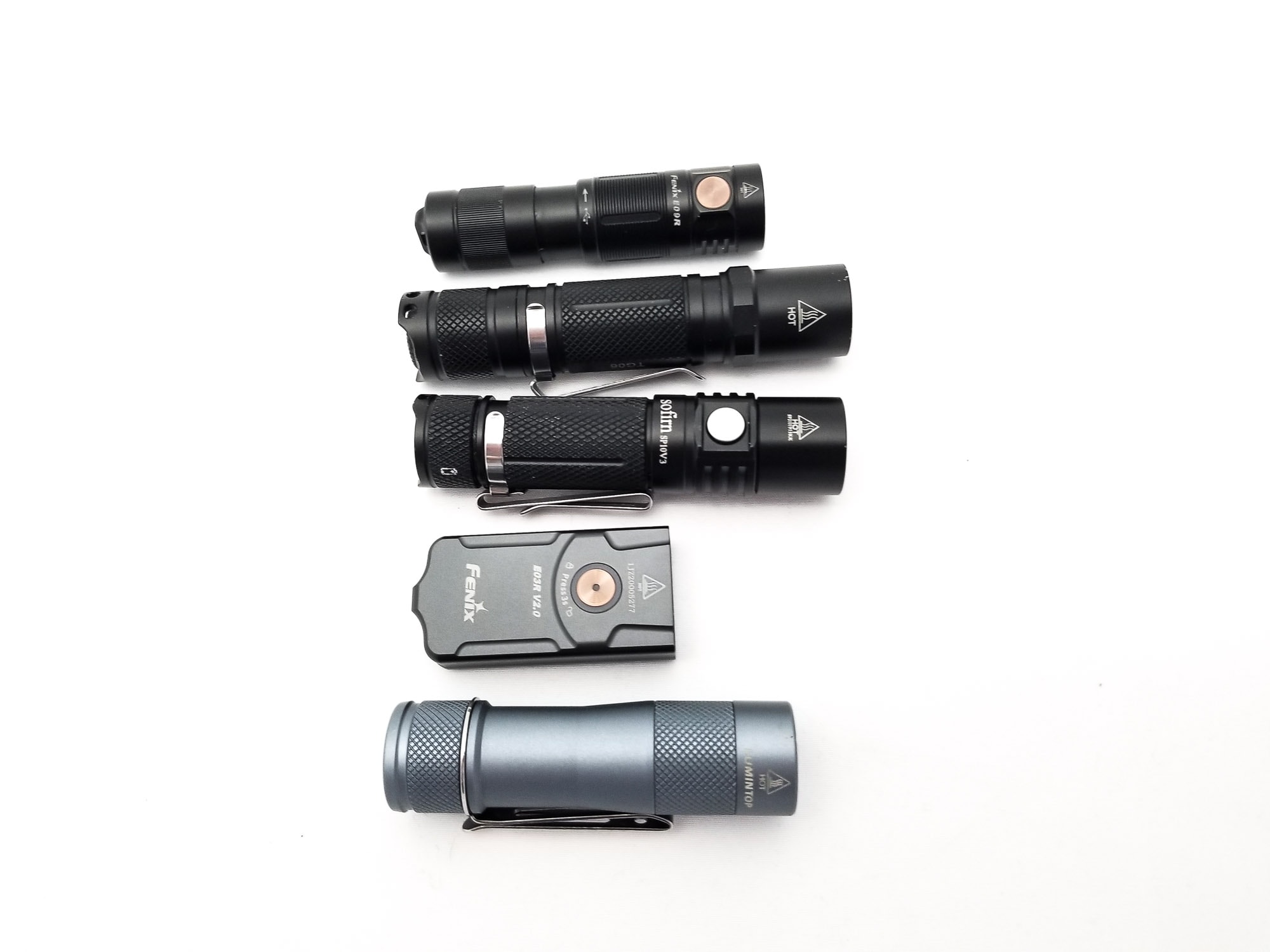
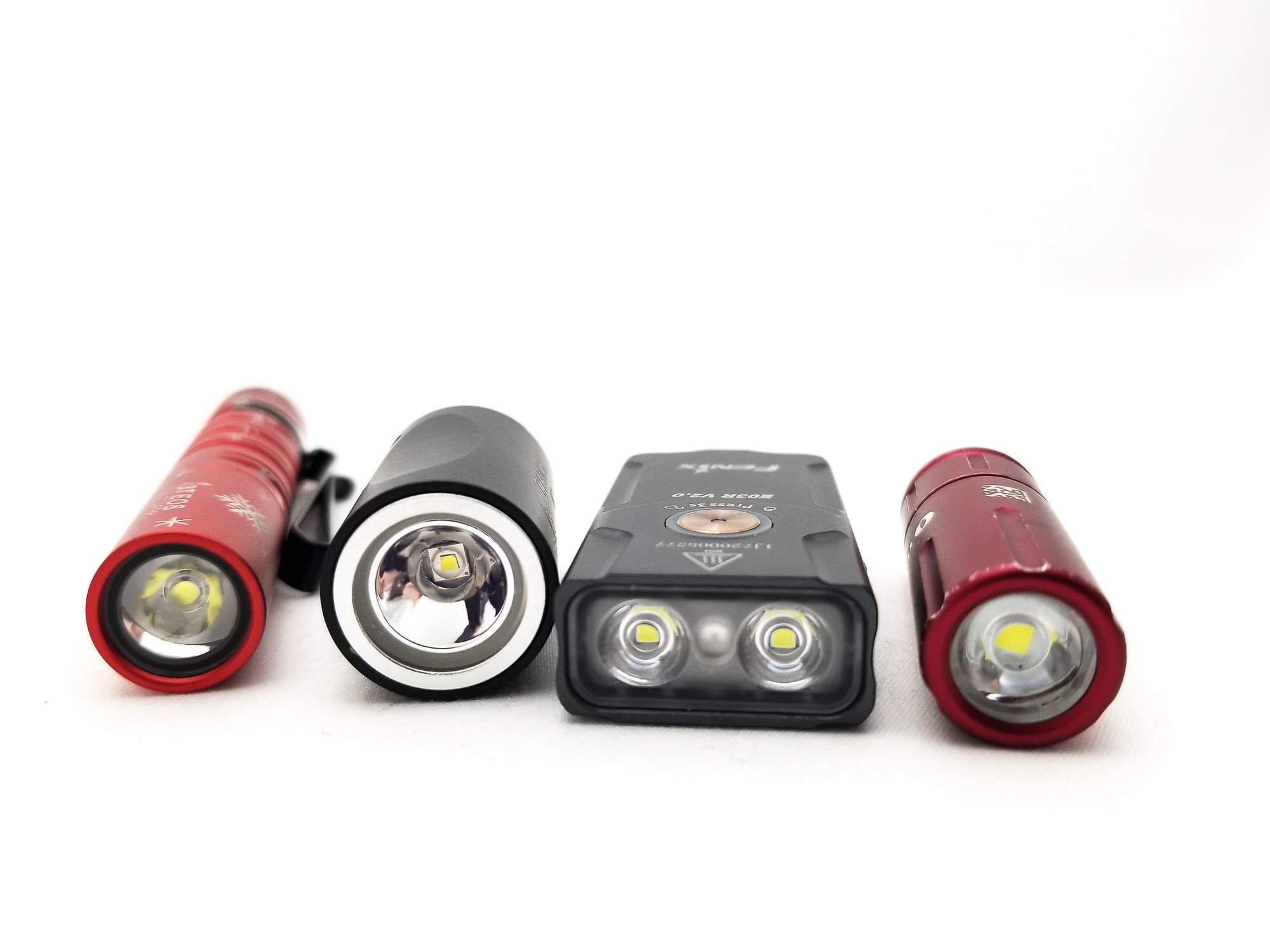
Fenix E03R v2 UI: User Interface and Driver
The driver is anyone’s guess, and it’s sealed in so I can’t say for sure. It has to run 3 LEDs, with one of differing voltage and current limits, so there’s probably a buck driver in there. The UI is simple and robust for a keychain light with 7 total modes in 2 lighting groups, one for the white LEDs and one for the red, and what Fenix calls ‘Pulse light’ where the switch LED pulses red.
Available modes:
- Eco, Low, Medium, High, Red, Red Flashing
Available blinky modes:
- N/A
From OFF:
- Click switch: Battery status lights uo
- Press and hold: Turns on in last mode
- Double click switch: Turns on pulse light
From ON:
- Press and hold: Turns off
- 1 click: Switches modes
- Press and hold for 1.2 seconds: Activates red LED. Click again in the red LED mode to activate the blinking function
Mode memory:
- Remembers last brightness level
Shortcuts:
- N/A
Low voltage warning:
- The light will drop to a very low level when the batteries reach a certain low voltage (not specified in the manual)
Strobe/blinkies
- N/A
Lock-out mode:
- From off, press and hold the switch for 3 seconds. The light blinks twice in Eco mode to acknowledge the lockout. Repeat to unlock. If the switch is pressed when locked, the switch indicator lights up and the light blinks twice in Eco mode.
PWM
- Yes, fast PWM not visible to the naked eye
Additional/summary info on the UI:
- This is a very simple, utilitarian UI from Fenix, and well a pretty loaded for a keychain light UI. I’m used to 2-3 modes max, so having this flexibility is very nice! I’ve never been a fan of press and hold for on, but you get used to it quickly, and it makes sense here (Even the Cyansky M2 has it). The lighting mode switching is intuitive, and identical to the E-Lite. However, I wish you could start the light in the red lighting mode from off instead of going through the white mode.
Fenix E03R v2 Charging and batteries
The Fenix E-series keychain lights have integrated non-user replaceable batteries. I know, I know, boooooo. Internal batteries are a bummer because when the battery goes flat (it will), the light goes in the recycle bin. I think I’d rather have a replaceable battery, but getting the form factor of this light to accommodate a replaceable battery would be tough and add to the complexity of the light, which hurts durability and would make it more expensive. I think this battery would last a long time also since the charge rate is low and the battery lives a pretty stress free life with charging and discharging.
It’s a 400 mAh li-po battery (50% bigger than the v1), so you should get good runtimes out of it. There’s also USB type C charging on board, for ease and convenience. My Ruideng AT35 tester shows around 280 mA during charging, and a depleted battery took around 362 mAh in about 2 hours. The switch LED turns red during charging, and turns green when finished.
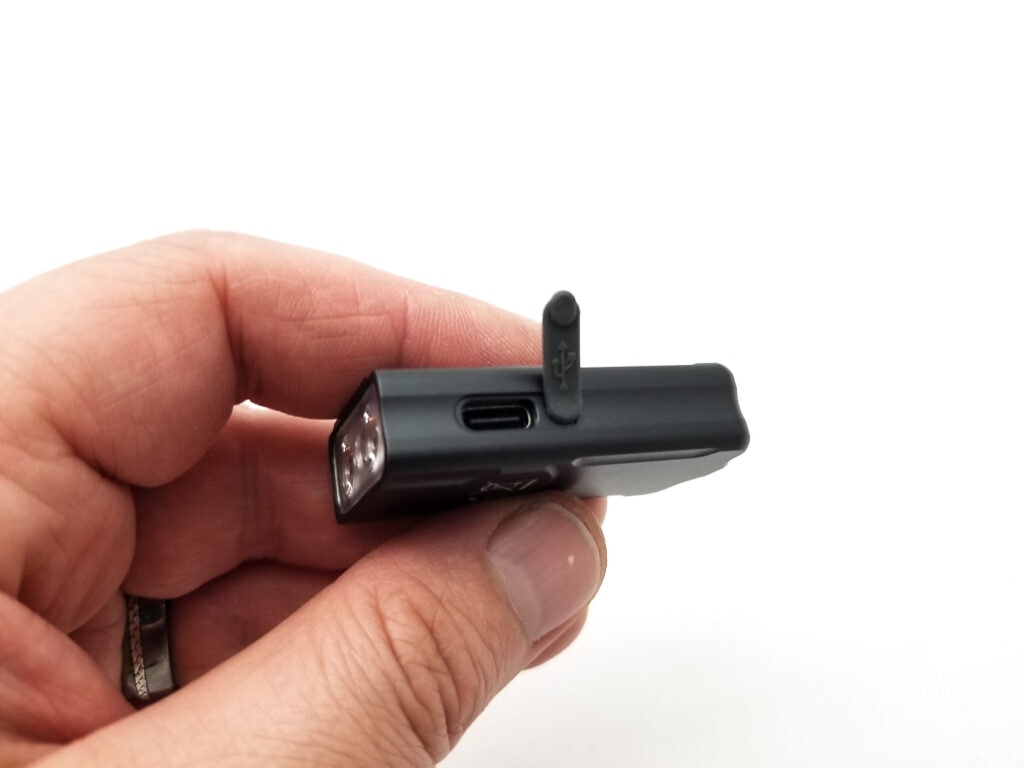
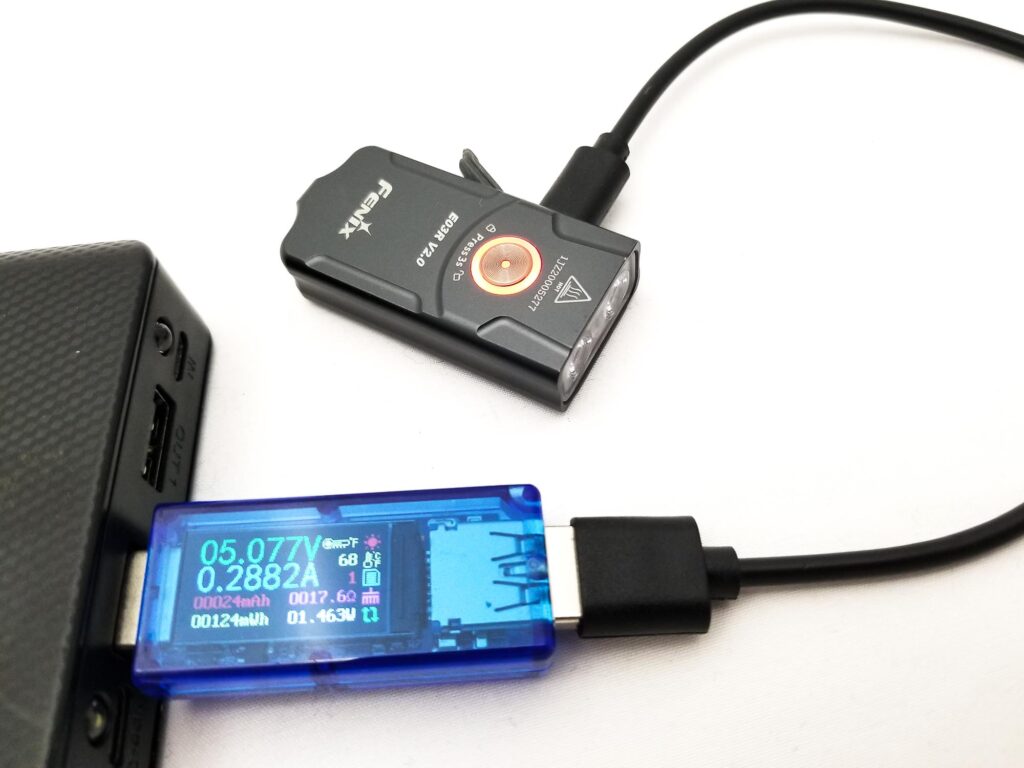
Performance test
Lumen measurements
How Lumens are Measured: Understanding ANSI FL1 Standards How Lumens are Measured: Understanding ANSI FL1 Standards: The ANSI FL1 standards specify that output in lumens should be measured 30 seconds after turning on, as this is the standardized time for measuring brightness according to the industry standard. This is why we focus on this part in our measurements. The ANSI FL1 standards require an ambient temperature of 22 ± 3°C. We record the ambient the ambient temperature to identify potential reasons for any observed discrepancies.Lumens are measured in my 50 cm integrating sphere with a Digi-Sense 20250-00 data logging luxmeter. The sphere has been calibrated with a Convoy S2+ measured to 260 Lumens and the figures are within 10% of actual. No current readings this time due to the inaccessible current path. The internal battery was fully charged for the tests.
| Mode | Specs | turn on | 30 sec | 10 minutes |
|---|---|---|---|---|
| Eco | 5 | N/A | N/A | – |
| Low | 30 | 25 lm | 25 lm | 24 lm |
| Medium | 150 | 149 lm | 146 lm | 82 lm |
| High | 500 | 467 lm | 283 lm | 111 lm |
| Red | 5 | N/A | N/A | – |
Parasitic drain:
- Not tested
I didn’t get a reading for Eco on the luxmeter (too dim), so it’s pretty dim and I believe the 5 Lumen figure. My big sphere reads down to about 1.5 to 2 Lumens. No reading for the red LED either. The other measurements are on point for output and within my 10% variability figure.
Fenix E03R v2 Battery Life: Runtime graphs
How Runtimes are Measured: Understanding ANSI FL1 Standards About ANSI FL1 runtime standards: The runtime is measured until the light drops to 10% of its initial output (30 seconds after turning on). This does not mean that the flashlight is not usable anymore. The last column shows how long the light actually works till it shuts off. If there is a + symbol, it means that the test was stopped at that particular point, but the light was actually still running. This happens on certain occasions, with certain drivers, firmware, or batteries.Runtimes are measured in my 50 cm integrating sphere with a Digi-Sense 20250-00 data logging luxmeter. The sphere has been calibrated with a Convoy S2+ measured to 260 Lumens and the figures are within 10% of actual. I measure temperature readings with my Digi-Sense 20250-92 data logging thermocouple. The thermocouple is affixed to the head with kapton tape, and I used the same 5 second sampling rate as the luxmeter. The internal battery was fully charged for the tests.
| Mode | Specified runtime | Measured runtime ANSI | Time till shut off |
|---|---|---|---|
| Low | 6h 35min | 5h 46min | 5h 46min |
| Medium | 2h | 2h 1min | 2h 1min |
| High | 1h 20min | 1h 9min | 1h 9min |
No complaints about the runtimes. There’s a fully regulated driver at work here and the output is laminar and pretty consistent across the runs. The runtimes are pretty bang-on against Fenix’s spec as well. The High output drops a bit low at the ANSI reading though, probably to keep the thermals in check since this is a small host. I can’t measure the termination voltage, but LVP drops the output pretty low with the switch LED flashing red before shut down. The light didn’t heat up too much, even on High mode and just got a bit warm, never hot or uncomfortable to hold. I did a comparison graph of the High modes from some other compact flashlights.
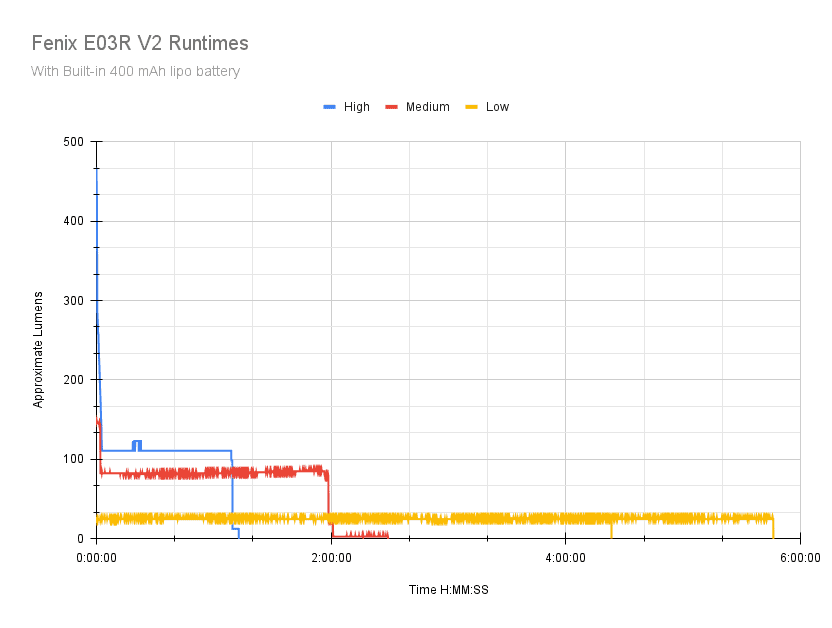
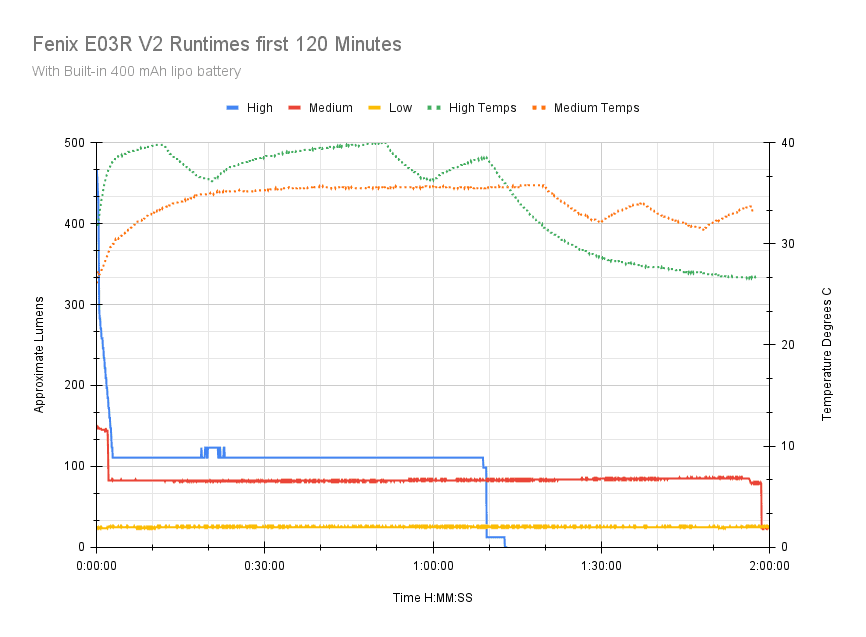
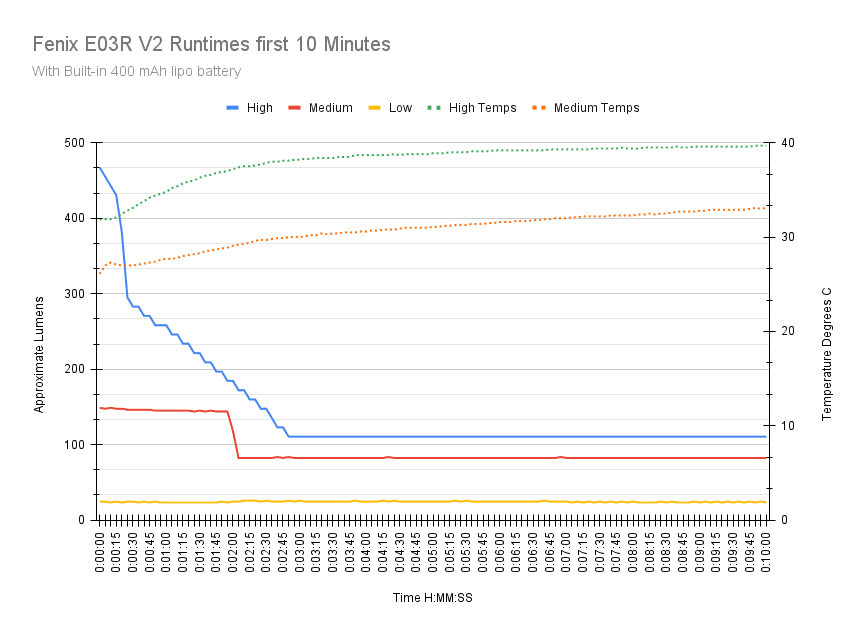
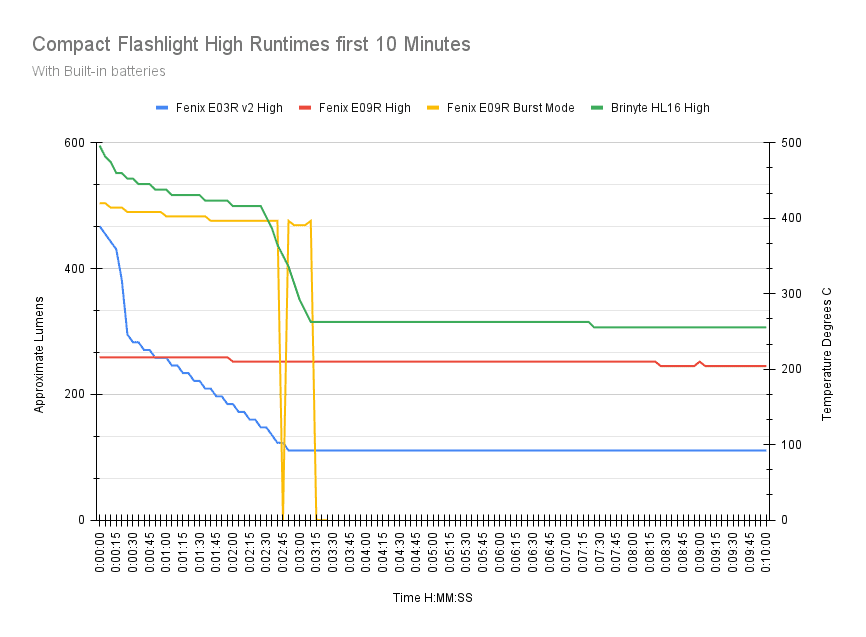
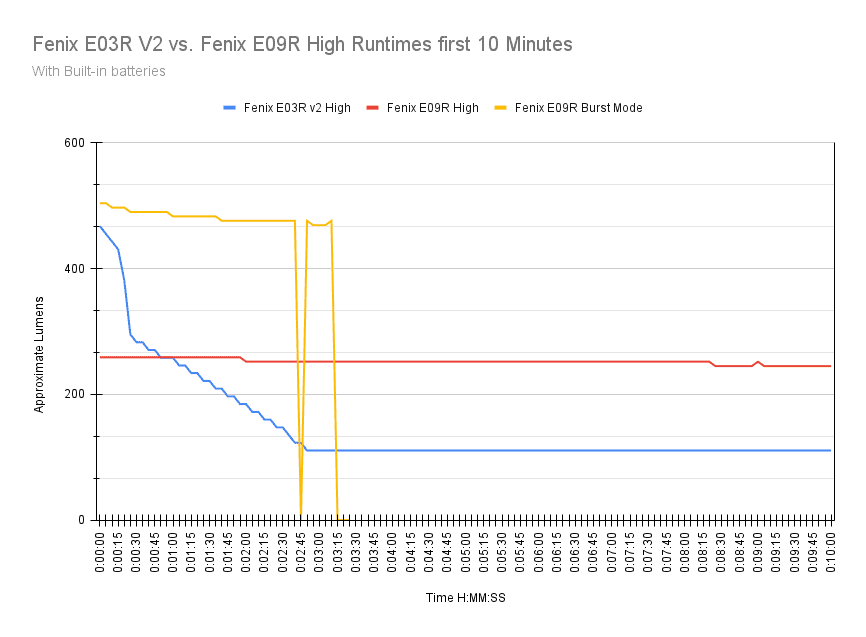
Peak beam intensity and beam distance measurements
About Peak beam intensity: Understanding ANSI FL1 Standards About peak beam intensity The calculated value of distance in meters at which the flashlight produces a light intensity of 0.25 lux. (0.25 lux is about the brightness of a full moon shining on an object). This means that the intensity has decreased so much, it becomes difficult to see darker objects, or objects that don’t reflect light. The columns ‘Meters’ and ‘Yards’ use rounded numbers.The beam distance test was conducted using the Uni-t UT383S luxmeter at a distance of 5 meters. The internal battery was fully charged, for the test. Measurements taken at 30 seconds per ANSI spec.
| Mode | Specs | Candela measured | Meters | Yards |
|---|---|---|---|---|
| Eco | 20 cd | N/A | N/A | N/A |
| Low | 127 cd | 100 | 20 | 22 |
| Medium | 630 cd | 675 | 52 | 57 |
| High | 2082 cd | 1450 | 77 | 84 |
| Red | ? | N/A | N/A | N/A |
Eco was too dim to register on the luxmeter at 5 meters, as was the red mode at 2 meters. These are close to Fenix’s numbers. The High figure is down a bit at ANSI because the output was already dropping by 30 seconds. At turn on, it meets the advertised spec. Compared to every other micro keychain light on the market, including their own E09R (which gets about as bright on it’s temporary ‘burst mode’), this is very respectable performance.
Beamshots
Photos taken with my Samsung Note 8 set to 1/15s ISO 100 and 5000K WB. You can see the difference in the different LEDs and reflector configurations. All except the BLF348 and the Cyansky have TIR lenses. Only the E09R has an output over 500 Lumens, but that’s on the ‘burst’ mode which is technically a momentary function.
Beamshots of the following flashlights compared:
- Fenix E03R v2
- Fenix E-lite (TIR)
- Fenix E09R (TIR)
- Olight i3t (TIR)
- Cyansky M200 (reflector)
- Killzone Flashlights BLF 348 (reflector)
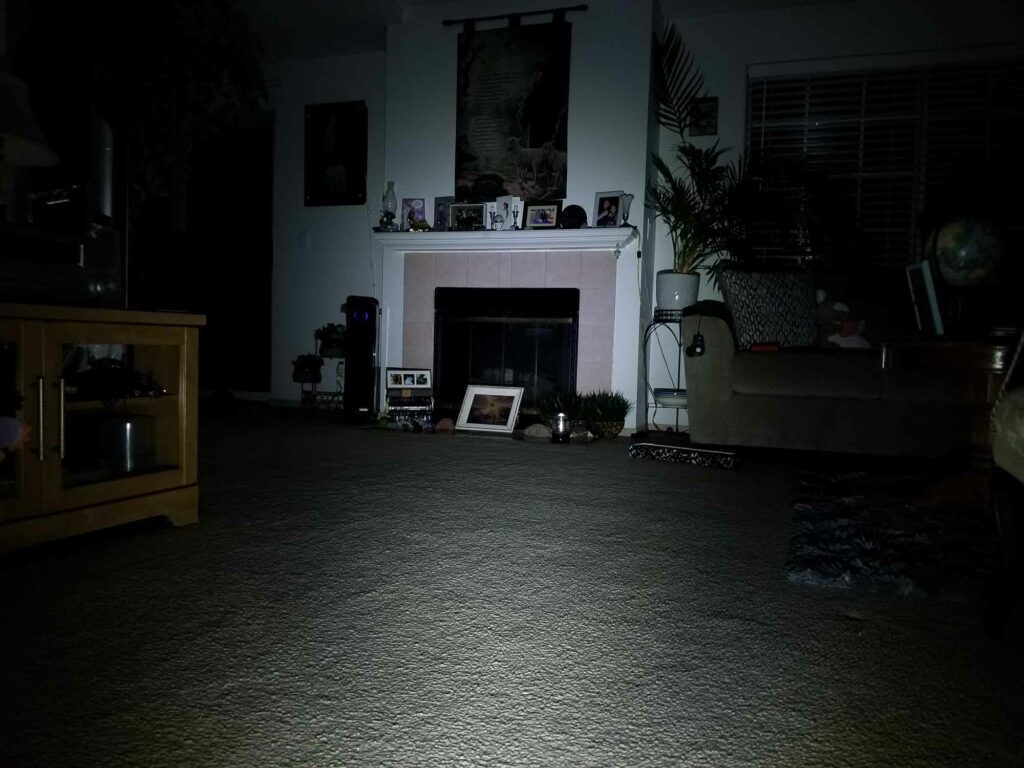
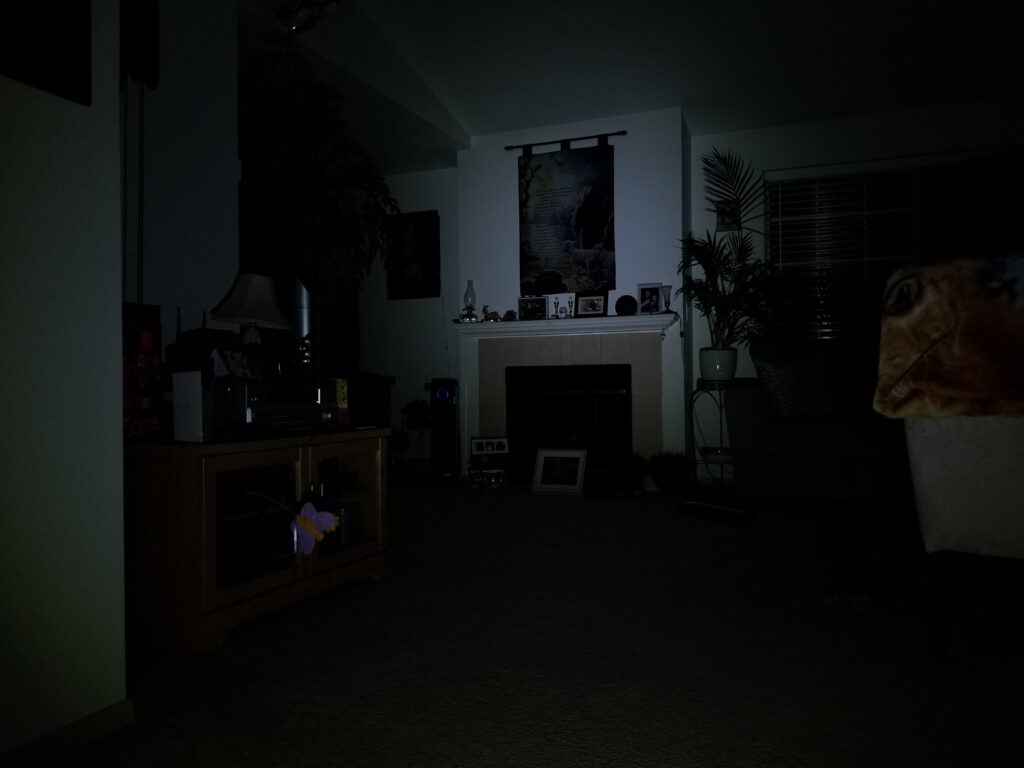
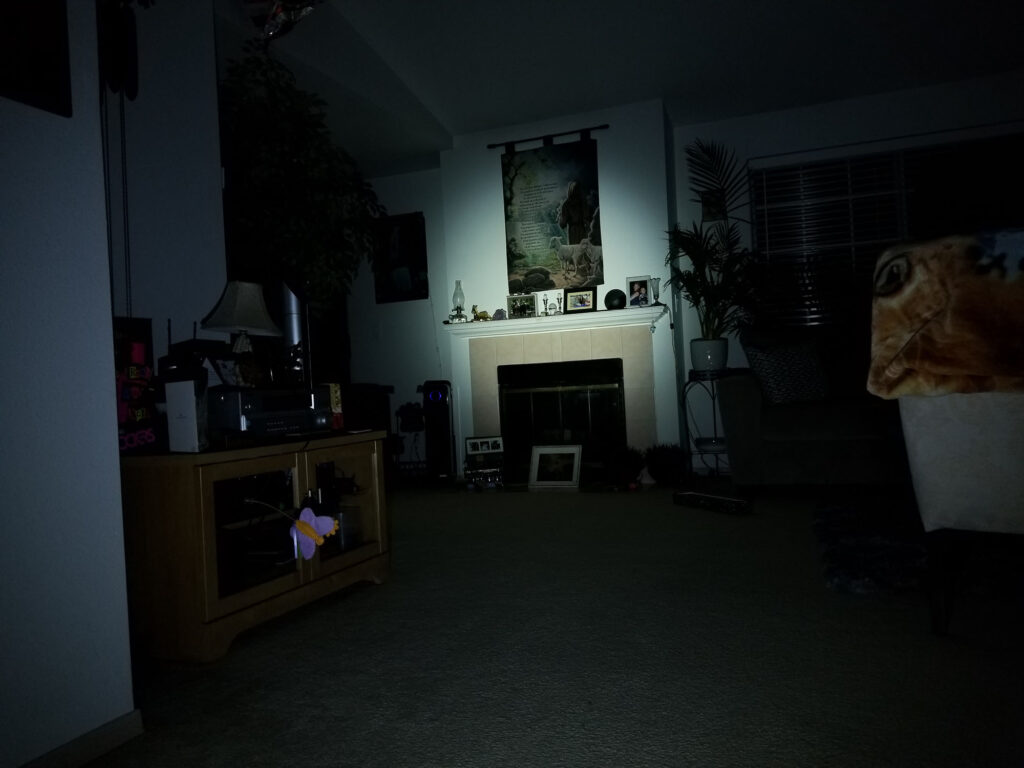
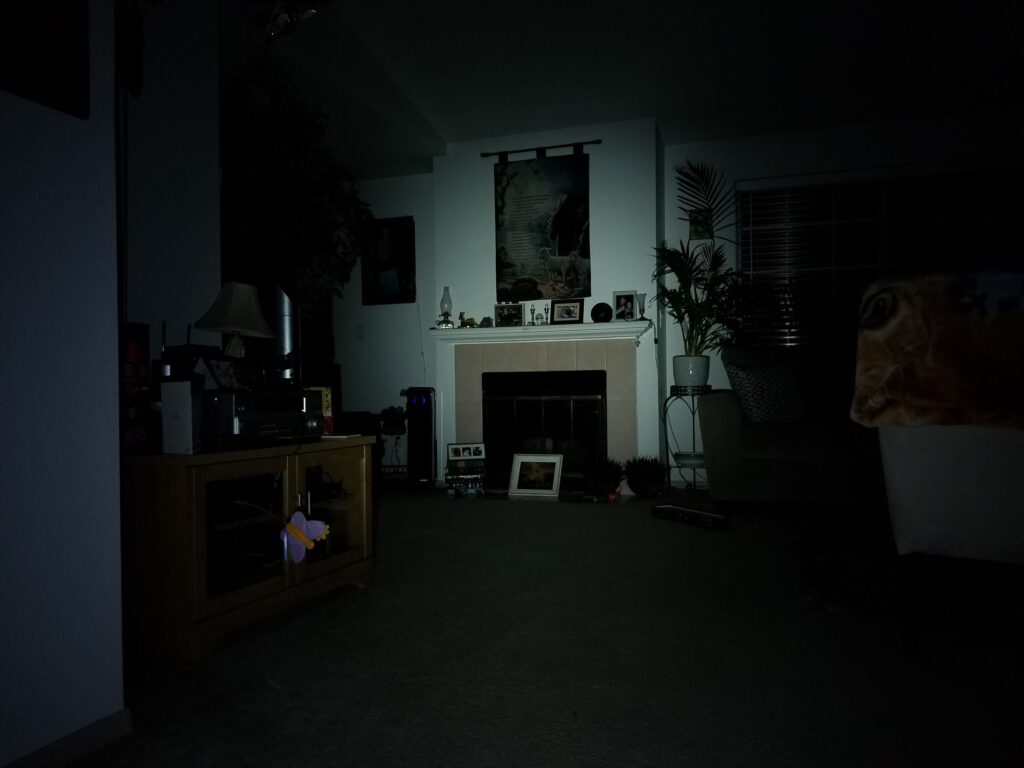
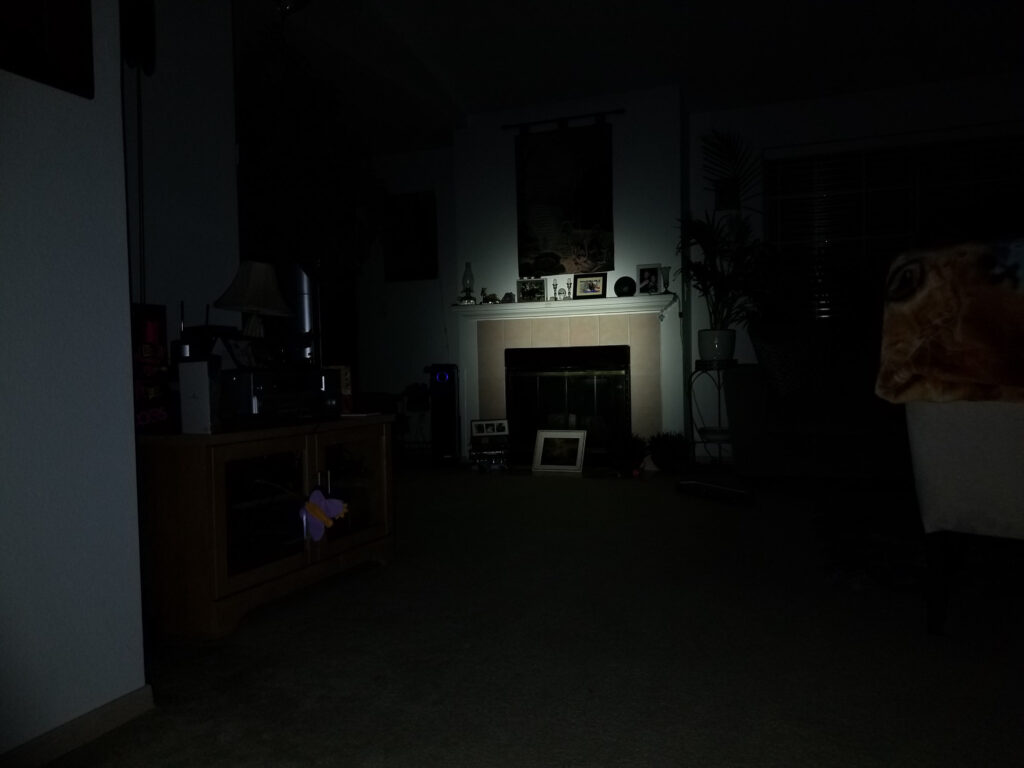
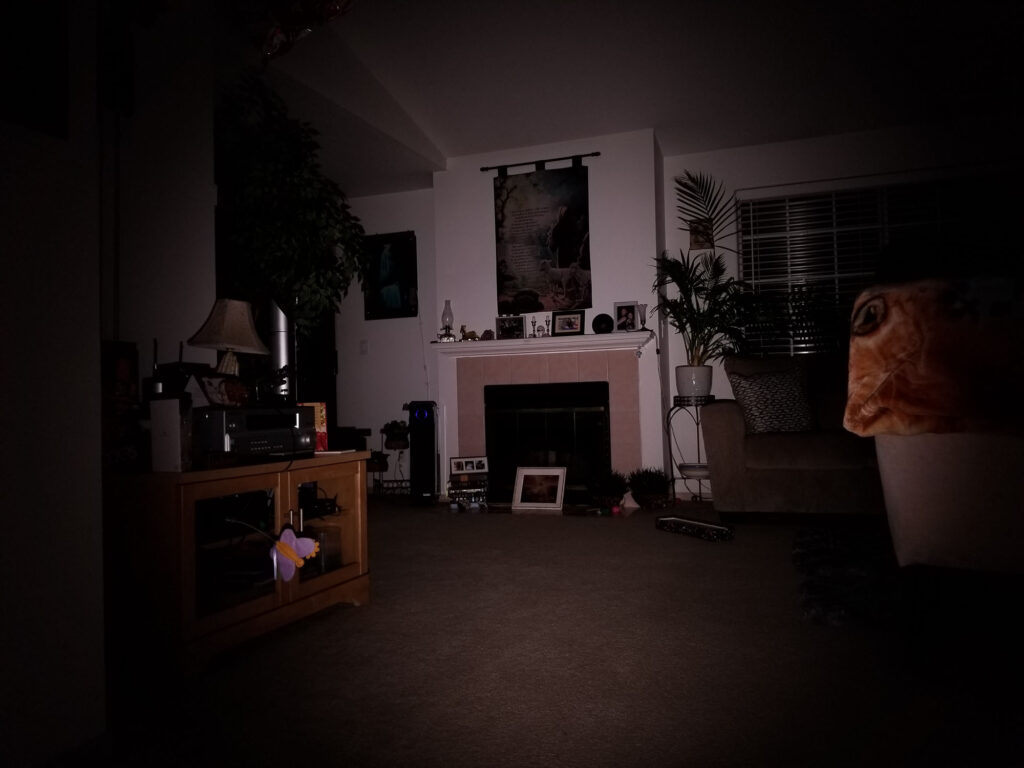
Disclaimer: This flashlight was sent to me for review at no cost by Fenix Lighting US. I have not been paid to review, nor have I been holding back on problems or defects.
Final Verdict
Pros
- Awesome build quality
- Simple, full featured UI
- Very compact for 500 Lumen output
- Red LED function
- Good performance with a regulated driver
- USB type C charging
Cons
- Internal battery isn’t serviceable
- A bit heavy for a keychain light
- Switch button is hard to find and manipulate
Explanation on star ratings:
1: Avoid: a match would be a better choice – 2: Poor: significant defect or issues; almost unusable – 3: Average: some defects or issues; but still usable 4: Good: recommended (minor issues) – 5: Great: highly recommended

4 stars: ★★★★
While our star rating provides a reliable indicator, we encourage you to read the full review to make an informed decision based on your own needs and preferences.
I’ve reviewed a few subcompact and keychain-ready flashlights over the years and owned a few too! Starting with the cheapest ones you get from the Dollar Tree or WalMart for like $1.00 or $2.00, they get the job done and are better than a match, candle, and marginally better than your cell phone camera (yep, I said it), but not good for much else. They don’t last long, are dim, and frankly, the beam color is north of ice blue. There’s some exceptions (like the Ozark Trail one you get from WalMart), but generally they’re a last resort light.
Stepping up in output, beam quality (and price!), you get into Olight, Nitecore, Cyansky, and of course, the Fenix offerings. I like this E03R v2. It’s very nice upgrade from the original E03R and super nice quality-wise. It’s well made, and performs great (500 Lumens from a light a bit smaller than a match box). I like the convenience features like USB type C charging and the generous battery.
However, I’m not a fan of the non-replaceable battery (but every Fenix keychain light so far has one), it is a bit portly for a keychain light at nearly 40 grams, and the switch…well, it needs some work. Compared to Fenix’s own E09R and E-Lite, and other offerings from Olight, the E03R v2 is a very nice alternative and will serve you well as a keychain/lanyard light, backup light, or glove box light. 4 stars for the E03R v2.
Buy your Fenix E03R v2 with a discount
Get 10% off every purchase at Fenix Lighting US, by using our exclusive 1lumen discount code: 1lumen10
1lumen selects and reviews products personally. We may earn affiliate commissions through our links, which help support our testing.